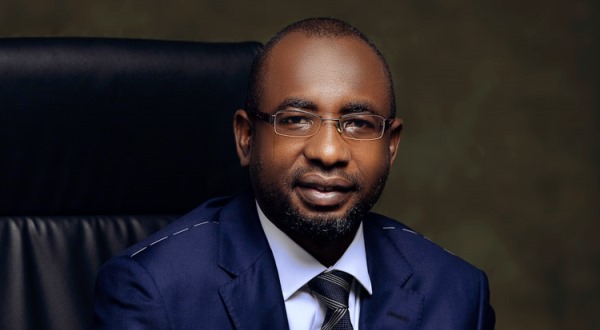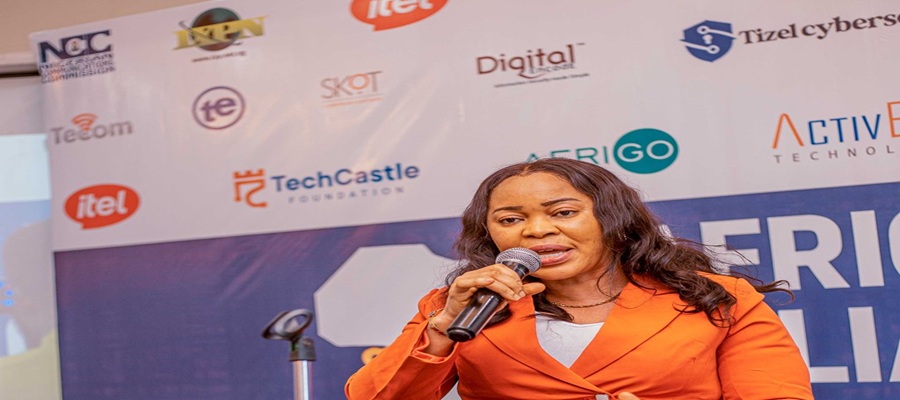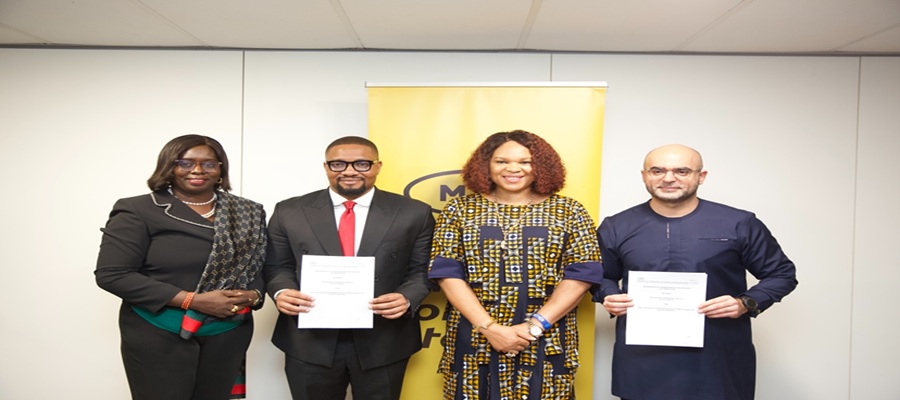Telecom
FG’s Intervention on Digital Literacy Covers Almajiris

The National Information Technology Development Agency (NITDA) says that the Federal Government efforts toward promoting digital literacy has started yielding results, indicating its 95 per cent digital literacy target by 2030 achievable.

?????????????????????????
Mallam Kashifu Inuwa, Director General of NITDA, made this known on Sunday at the graduation ceremony of 50 children, including 10 Almajiris at the Engausa Global Tech Hub in Kano State.
The young children were subjected to extensive training for two-weeks on innovative digital skills on Computer Networking, Installation of CCTV camera, Graphic Design, innovative creativity, among others.
Engausa Global Tech Hub is an Incubation centre, currently working in collaboration with NITDA in Kano, where young boys are being subjected to entensive training at their early stage, using Hausa language in building their skills on digital technology.
Inuwa said that the centre had in 2021 trained over 700 young boys who were selected from various rural communities in the state, adding that he was very happy that the centre has cooped young Almajiris into the system.
“We have been collaborating with Engausa like the founder said. As a result of intervention we have done for the centre last year, they had multiplied the number of people they trained. In 2021 they trained more than 700 people in this centre as a result of this collaboration,” he said.
Kashifu added that the agency have been expanding the collaboration and we are going to do more with them this year to see how we can help the less privileged children to have access to digital technology.
“One of our mandate is to implement the policy under the National Digital Economy Policy for digital Nigeria to logical conclusion in achieving the 95 per cent digital literacy by 2030.
“You know government cannot do it alone, we need to partner with centres like Engausa to achieve this. So, we are working with them to even expand this centre beyond Kano to other States and also to see how we can equip them more,” DG added.
Explaining further, Kashifu said; “we are also looking at how we can assist the children who have participated in this programme to start their own businesses.”
Earlier, the founder of the centre, Mr Mustapha Ringim, said the centre was out to bridge the productivity gap among the young people, especially those who cannot make it in formal school.
“I realised that there are a lot of things that I can offer to the community concerning breaking some barriers and bridging some gaps which are limiting the productivity of our youth, especially the downtrodden ones at the grassroot, the Almajiris, and school-drop-outs who cannot continue their studies due to lack of proficiency in English Language, among other things,” he said.
Ringing said he realised that Language should not be a barrier to achieving one’s dream, especially when it comes to global world. He argued that there are lot of developments in countries which are not using English Language as medium of learning skills, like European countries where English is not well spoken but still technology, innovation and creativity is flourishing in those countries.
“So, I realised that English Language is not the only medium of learning skills, it is not the only medium of prosperity when it comes to knowledge and when it comes to practicing what you know.
That is why I break the language barrier of English and domesticated the technology and the skills I have in me so that the people will easily tap from my knowledge through the use of Hausa language for better understanding of the subject matter, ” he explained.
Telecom
Africa Must Build Its Own Cybersecurity Intelligence, Says Tizel CEO At AfriTech 5.0

As Africa edges toward an estimated 750 million internet users by the end of 2025, the continent’s expanding digital footprint is increasingly matched by vulnerabilities that threaten its economic and national security.

Happiness Obioha, Managing Director and Chief Executive Officer of Tizel Cybersecurity
This concern took centre stage at the Africa Tech Alliance Forum (AfriTech 5.0), where Happiness Obioha, the Managing Director and Chief Executive Officer of Tizel Cybersecurity, delivered one of the event’s most compelling arguments for a new cybersecurity paradigm rooted in African intelligence rather than foreign technology.
Speaking on the theme “Beyond Firewalls: The Case for Homegrown Cybersecurity Intelligence in Africa,” Obioha maintained that Africa’s cybersecurity risks cannot be effectively mitigated with imported solutions that were never designed for the continent’s distinct digital realities.
She described Africa’s cyber landscape as one defined by unique threat actors, infrastructural limitations, cultural nuances, and business patterns that global security platforms often fail to understand.
According to her, relying solely on perimeter-based defenses such as firewalls is no longer adequate in a world where cyberattacks grow more adaptive, persistent, and sophisticated.
Obioha argued that Africa’s dependence on generic global tools has created a critical gap in the continent’s ability to detect, interpret, and respond to emerging threats, and explained that foreign cybersecurity systems frequently misread local attack patterns or fail to anticipate region-specific vulnerabilities.
As a result, many African organizations operate with a false sense of safety while facing increasingly complex threats ranging from ransomware and financial fraud to targeted breaches on government infrastructure.
The Tizel CEO emphasised that Africa’s long-term security lies in adopting intelligence-led approaches that draw from local insights, indigenous expertise, and continental research, and noted that such solutions allow faster and more precise threat detection because they are built with an understanding of local behaviour patterns and digital environments.
Beyond security improvements, she stressed that homegrown cybersecurity also strengthens national sovereignty, reduces capital flight, expands technical capacity, and creates jobs in one of the world’s fastest-growing sectors.
Obioha cited Tizel Cybersecurity as an example of what locally grounded innovation can achieve, explaining that the company’s model integrates contextual intelligence, real-time monitoring, rapid incident response, and strict adherence to regulatory frameworks.
According to her, Tizel’s work with banks, telecom operators, government agencies, and SMEs demonstrates the measurable impact of Africa-specific cybersecurity architecture.
Among the results she highlighted were the prevention of a major ransomware attack in the financial sector, a significant reduction in network downtime for a telecom operator, and the deployment of effective real-time monitoring systems for a government agency.
She reinforced that Tizel’s success is built on its deep understanding of the African digital ecosystem, a familiarity she described as indispensable for delivering cybersecurity that genuinely protects African institutions.
The region’s business culture, infrastructural diversity, and evolving digital habits, she said, can only be accurately interpreted by experts who operate within the same environment.
Obioha urged African enterprises and governments to take a more deliberate approach toward securing their digital future, and encouraged them to re-examine their cybersecurity posture, invest in indigenous intelligence-driven solutions, and build internal teams equipped to respond to emerging threats.
The survival and competitiveness of African businesses, she noted, will increasingly depend on their ability to align security strategies with the realities of the continent’s rapidly evolving digital economy.
“Africa’s digital future is promising,” she concluded, “but it must be secured with intelligence and innovation that come from within the continent.”
Telecom
MTN Partners with SMEDAN to Drive Digital Growth and Job Creation Nationwide

MTN Nigeria and the Small and Medium Enterprises Development Agency of Nigeria (SMEDAN) have signed a strategic partnership aimed at accelerating the growth, digital capacity, and sustainability of Nigeria’s 40 million Micro, Small and Medium Enterprises (MSMEs).

L-R: Julcit Onigbogi, Head of Legal, SMEDAN; Charles Odii, Director General, SMEDAN; Lynda Saint-Nwafor, Chief Enterprise Business Officer, MTN Nigeria and Ayham Moussa, Chief Operating Officer, MTN Nigeria, during the MTN, SMEDAN Seal Strategic Partnership Signing held at the MTN Plaza, Ikoyi on Thursday, November 27, 2025.
The signing ceremony was held at the MTN Plaza, Lagos, on Thursday, November 27, 2025.
MTN Nigeria’s Chief Operating Officer, Ayham Moussa, reiterated MTN’s commitment to supporting Nigeria’s economic development, stating that MSMEs are the lifeline of Nigeria’s economy.
He said: “SMEs are the backbone of the economy and the backbone of employment in Nigeria. We are delighted to power SMEDAN’s platform and provide tools that help MSMEs reach customers, obtain funding, and access wider markets.
“This collaboration serves both our business and social development objectives.”
Chief Enterprise Business Officer, Lynda Saint-Nwafor, MTN Nigeria described the MoU as a tool to “meet SMEs at the point of their needs,” noting that nano, micro, small, and medium businesses each require different resources to scale.
She stated: “Some SMEs need guidance, some need resources; others need opportunities or workforce support. This platform allows them to access whatever they need.
“We are committed to identifying opportunities across financial inclusion, digital inclusion, and capacity building that help SMEs to scale.”
Speaking at the event, the Director General of SMEDAN, Charles Odii, emphasised the significance of the collaboration, noting that the agency cannot meet its mandate without leveraging technology and private-sector expertise.
He said: “We have approximately 40 million MSMEs in Nigeria, and only about 400 SMEDAN staff. We cannot fulfil our mandate without technology, data, and strong partners.
“MTN already has the infrastructure and tools to support MSMEs from payments to identity, hosting, learning, and more. With this partnership, we are confident we can achieve in a short time what would have taken years.”
Odii highlighted that the SMEDAN-MTN collaboration would support businesses across their growth needs, guided by their four-point GROW model – Guidance, Resources, Opportunities, and Workforce Development.
He added that SMEDAN has already created over 100,000 jobs within its two-year administration and expects the partnership to significantly boost job creation, business expansion, and nationwide enterprise modernisation.
The partnership will feature joint initiatives focused on digital inclusion, financial access, capacity building, and providing verified information for MSMEs. With millions of small businesses depending on accurate guidance and easy-to-access support, MTN and SMEDAN say their shared platform will address gaps in communication, misinformation, and access to opportunities.
The event concluded with the formal signing of the Memorandum of Understanding (MoU), setting the stage for the immediate roll-out of tools, content, and resources that will support MSMEs nationwide.
Telecom
MTN Nigeria Launches Y’ello Data Gifting Campaign as Digital Connectivity Shapes Festive Celebrations

MTN Y’ello Tide is the gift that keeps giving, with MTN exciting Nigerians through a season filled with yellow gifting, digital rewards, and festive moments. This year, MTN is giving customers even more ways to stay connected and celebrate, and the Y’ello Data Gifting initiative stands as one of the many offerings under MTN Y’ello Tide.

MTN Nigeria
With Nigerians embracing more digital-led ways to connect and celebrate during the festive season, MTN Nigeria has introduced its Y’ello Data Gifting initiative as part of the broader MTN Y’ello Tide, designed to encourage customers to share data with loved ones while standing a chance to win prizes worth millions of naira. MTN Y’ello Tide continues to position digital connectivity as an exciting way to gift this season, reinforcing that MTN is giving Nigerians more value at a time they need it most.
The campaign runs from December 1 to 25, offering daily rewards such as Samsung smartphones and ₦20,000 shopping vouchers for the top 20 data gifters each day. As a core part of MTN Y’ello Tide, the data gifting experience helps customers enjoy more yellow moments through rewards, bonuses, and shared connections. Customers who participate also enjoy bonus data, with 1GB awarded to those gifting 10GB or more, and 500MB for gifts ranging between 5GB and 9.99GB. Participation is available through *321# or the myMTN NG app between 10am and 10pm daily.
Across Nigeria, digital behaviour continues to evolve. Internet consumption reached a record 973,455 terabytes in December 2024, marking a 36.5 percent year-on-year growth according to the Nigerian Communications Commission. MTN Y’ello Tide taps into this shift by offering exciting, value-driven digital gifting experiences that help people stay connected throughout the season.
While costs of food and non-alcoholic beverages have risen by over 92 percent in the last three years, and inflation stood at 34.60 percent in November 2024 with food inflation at 39.93 percent, Nigerians continue to prioritise meaningful and cost-efficient ways to stay connected. This shift has led many families to favour experiential or digital gifts, particularly as surveys show that 76 percent of Nigerians experienced income reductions in 2024, based on the PiggyVest Savings Report.
Festive spending has also adjusted to new realities. Items such as Christmas trees now range between ₦23,000 and ₦700,000, up from ₦17,000 to ₦450,000 last year. In this context, telco-led promotions like MTN Y’ello Tide’s Data Gifting campaign offer an alternative form of giving that aligns with today’s lifestyle needs. MTN is giving customers more ways to celebrate in yellow, creating exciting opportunities to share, connect, and enjoy festive rewards.
Nigeria remains a mobile-first market with 103 million internet users recorded at the start of 2024, representing 45.5 percent internet penetration according to DataReportal. Data now functions as a core utility supporting work, education, entertainment, and social connection across the country, making MTN Y’ello Tide’s digital gifting even more relevant this season.
As a Lagos civil servant noted earlier this month, the season remains a time for gratitude and connection, regardless of spending patterns. MTN Y’ello Tide strengthens this sentiment by making it easier for customers to stay connected and enjoy meaningful gifting in an exciting and accessible way.
The Y’ello Data Gifting campaign continues until December 25, with terms and conditions applying. As part of MTN Y’ello Tide, the initiative reinforces that MTN is giving Nigerians a festive season anchored on digital convenience, rewarding experiences, and yellow-themed celebration.
Dial *321# or download the myMTN NG app to start gifting data to your loved ones. Campaign runs until December 25, 2025. Terms and conditions apply.

 Broadcasting2 days ago
Broadcasting2 days agoIt is Official, DStv Confirms Termination of 16 Major Channels

 E-Financial2 days ago
E-Financial2 days agoSenate Considers Bill to Empower CBN to Regulate Fintech

 Broadcasting2 days ago
Broadcasting2 days agoParamount Africa Shuts Down after 20 Years

 News2 days ago
News2 days agoAfreximbank Taps Nigeria to Lead Africa’s Digital Trade Revolution

 E-Financial2 days ago
E-Financial2 days agoBinance Launches ‘Binance Junior’ Crypto Savings Account for Kids and Teens

 Telecom2 days ago
Telecom2 days agoSenator Akpoti Tops Google Searches in Nigeria’s 2025 Year in Review

 Telecom2 days ago
Telecom2 days agoAfrica’s $1bn Biometric ID Rollout Raises Concerns Over Privacy and Exclusion

 E-Business2 days ago
E-Business2 days agoGenAI Adoption Among African workers Outpace Global Peers



























